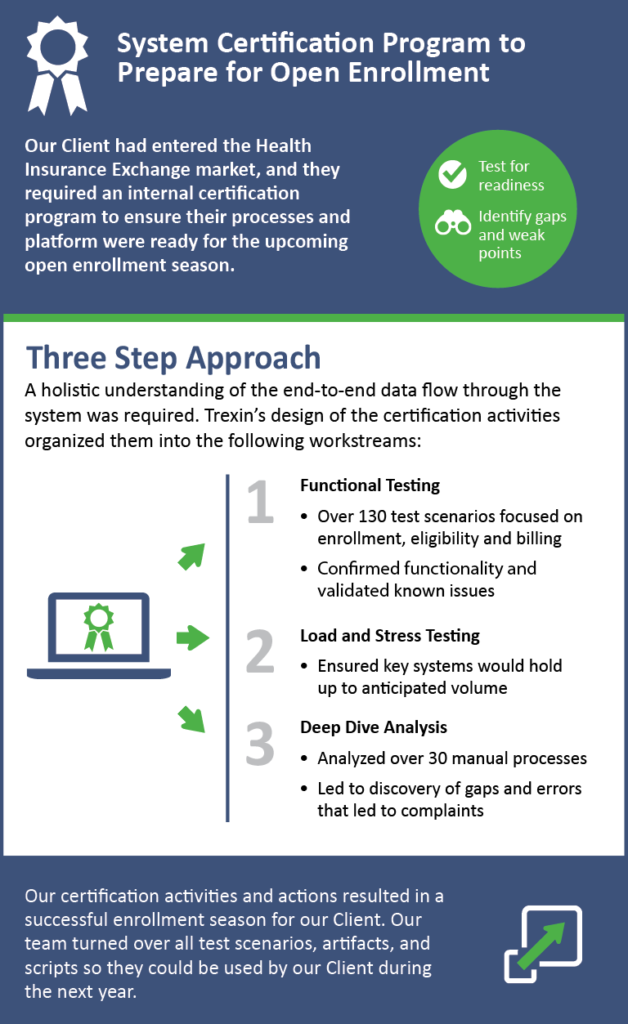Case Study August 3, 2016
Orchestrating System Certification for Health Insurance Exchanges
Trexin helped a large health services company that was entering the public Health Insurance Exchange market create and perform a system-wide internal certification program to ensure that their platforms were ready for the upcoming open enrollment season.
Business Driver
Our Client, an established health services company, had recently stepped into the public Healthcare Insurance Exchange market and discovered that their existing process and platform were struggling to keep up with the demands placed on them. Our Client needed these systems to be functioning efficiently and effectively because going into the open enrollment season, they were going to enter several new Federally Facilitated Marketplaces (FFM), driving up the volume of information the system had to handle. They wanted a way to test for readiness and identify problems that needed to be fixed.
The VP of Information Technology asked Trexin to build and orchestrate an internally imposed certification program. This program would consist of a series of activities designed to identify gaps and weak spots in their business processes and technology platforms with the ultimate goal of ensuring readiness for the upcoming open enrollment season.
Approach
We began with an assessment of the current system and soon discovered that it was made up of several sub-systems managed by isolated teams and that there were few staff members possessing a holistic understanding of the way that data flowed through the system. Each team knew their role but had limited knowledge of the stages upstream and downstream of their particular area of responsibility. This presented a significant challenge and required our team to piece together an understanding of the end-to-end data flow and build our own expertise through iterative work and trial and error as we developed the certification activities. Once we had gained this expert knowledge, our team designed and organized the certification activities into three workstreams:
- Functional testing of over 130 test scenarios focused on enrollment, eligibility, and billing and designed to confirm proper functionality of the system or to validate known issues.
- Load and stress tests of key technology systems to determine the system’s ability to hold up to the anticipated volume that it would be subjected to.
- Deep dive analysis of roughly 30 critical manual processes to address the problems resulting from the lack of visibility from one team to another. Many of these were imperfect manual processes that were the likely source of many complaints from the government and members. A small team was dispatched to watch the staff work, execute on the processes, and see where errors occurred.
Our team created detailed documentation of the test scenarios they performed and the discoveries they made as they worked through the certification activities.

Results
Our Client’s open enrollment season was a success. Because of the certification activities and the action taken to solve the problems that were uncovered, our Client enjoyed increased operational stability with a larger market footprint, a scalable technology platform, streamlined manual processes, and customer satisfaction metrics that fell within acceptable levels. Health Insurance Claims (HICs) case volume—one of their key success metrics—trended down and stayed in an acceptable range throughout the season. We also delivered the summary of all test scenarios and presented our Client with all artifacts, test scripts, and discoveries so that they could be used again the following year.

